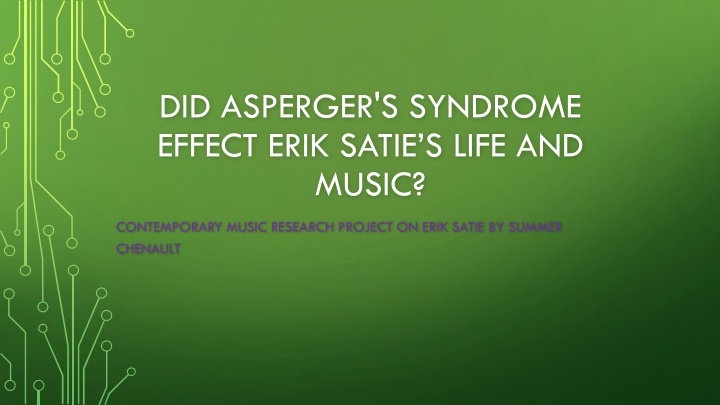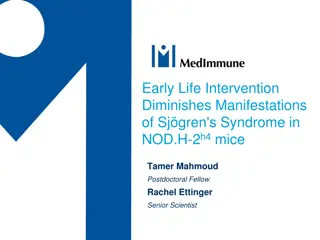The Influence of Asperger's Syndrome on Erik Satie's Life and Music
Erik Satie, a French neoclassical composer, displayed eccentric traits and his music was initially deemed odd but later revered. Researchers suggest he exhibited characteristics of Asperger's Syndrome. Satie's early life, challenges with formal music education, and unique style in the neoclassical era are explored. His preference for neoclassical music, rooted in order and restraint, is linked to struggles in forming emotional connections with others.
Download Presentation

Please find below an Image/Link to download the presentation.
The content on the website is provided AS IS for your information and personal use only. It may not be sold, licensed, or shared on other websites without obtaining consent from the author.If you encounter any issues during the download, it is possible that the publisher has removed the file from their server.
You are allowed to download the files provided on this website for personal or commercial use, subject to the condition that they are used lawfully. All files are the property of their respective owners.
The content on the website is provided AS IS for your information and personal use only. It may not be sold, licensed, or shared on other websites without obtaining consent from the author.
E N D
Presentation Transcript
DID ASPERGER'S SYNDROME EFFECT ERIK SATIE S LIFE AND MUSIC? CONTEMPORARY MUSIC RESEARCH PROJECT ON ERIK SATIE BY SUMMER CHENAULT
ERIK SATIE A 19thcentury French neoclassical composer Was known for his eccentric personality His music was ground breaking, at first considered odd, then became greatly appreciated Was he just an odd fellow, or did his personality have a deeper origin Researchers believe that he had the prime characteristics of Asperger s Syndrome
SATIES EARLY LIFE He was born in Normandy, France on May 17th, 1866 and died July 1, 1925 At the age of four, his family moved to Paris When Satie was 6 years old, his mother died and he and his brother were sent to live with their grandparents Satie received his first piano lesson from his grandparents Later he was reintroduced to his father and his new wife a piano teacher aanf his father published music
YOUNG ADULTHOOD Satie was later excepted into the Paris Conservatoire to study music He was asked to leave after being deemed not talented Later he was reaccepted to Paris Conservatoire but was again asked to leave He was not known at all until his father published some of his compositions He gained more recognition as an artists when others heard him playing piano in cafes Because of his opposition to French romantic era of music, he was not popular until he was noticed buy other muscians for his unique and interesting pieces
THE START OF NEOCLASSICISM French neoclassicism is defined as, a trend in which composers sought to return to aesthetic precepts associated with the broadly defined concept of "classicism", namely order, balance, clarity, economy, and emotional restraint. As such, neoclassicism was a reaction against the unrestrained emotionalism and perceived formlessness of late romanticism ("Neoclassical Music - New World Encyclopedia", 2016). This music was not based on emotion but more based on the forms of music. The music is very orderly and calmly and has a sense of restraint
WHY DID SATIE ENJOY NEOCLASSICAL MUSIC As stated before the previously popular music in France was romantic music which was all about emotion and connecting to others Erik Satie had a trouble making deeper connections to people which led to his disdain of Romantic style music Many people believe that this was because of his perceived Asperger s Syndrome
ASPERGERS SYNDROME Asperger s Syndrome is an Autism Spectrum Disorder and is clinically defined as affected children and adults (who have) have difficulty with social interactions and exhibit a restricted range of interests and/or repetitive behaviors. Motor development may be delayed, leading to clumsiness or uncoordinated motor movements however, those with Asperger syndrome do not have significant delays or difficulties in language or cognitive development. Some even demonstrate precocious vocabulary often in a highly specialized field of interest ("Asperger Syndrome", 2016) Asperger s affects every 1 out of 200 people A high functioning form of Autism in which social skills are most lacking
ASPERGERS SYNDROME CONTD People with Asperger s can succeed in many areas and disciplines but mainly struggle with social norms, emotions, and communicating with peers The most frequent behaviors associated with Asperger s Syndrome are inappropriate social interactions, robotic speech, the tendency to discuss themselves and not others, special interests, and a love of routines. Satie showed many of these characteristics in his daily life After he was deceased, his family found other clues that he was not living an typical lifestyle.
SATIE AND ASPERGERS SYNDROME An example of Satie s love for routines is demonstrated in this journal except: I rise at 7.18; am inspired from 10.23 to 11.47. I lunch at 12.11 and leave the table at 12.14. A healthy ride on horse-back round my domain follows from 1.19 pm to 2.53 pm. Another bout of inspiration from 3.12 to 4.7 pm. From 5 to 6.47 pm various occupations (fencing, reflection, immobility, visits, contemplation, dexterity, natation, etc.) Dinner is served at 7.16 and finished at 7.20 pm. From 8.9 to 9.59 pm symphonic readings (out loud). I go to bed regularly at 10.37 pm. Once a week (on Tuesdays) I awake with a start at 3.14 am. (Satie 2016).
SATIE AND ASPERGERS SYNDROME CONTD Another peculiar practice that Satie continued during his life was only eat white foods, even if those foods were molded. My only nourishment consists of food that is white: eggs, sugar, shredded bones, the fat of dead animals, veal, salt, coco-nuts, chicken cooked in white water, moldy fruit, rice, turnips, sausages in camphor, pastry, cheese (white varieties), cotton salad, and certain kinds of fish (without their skin) (Satie 2016). Also in his journals, Satie describes his lack of social capability. He states that his expression is very serious; when I laugh it is unintentional, and I always apologize very politely (Satie 2016). Lastly, after Satie s death in 1925 his father and brother were the first people in his room in 27 years, and he had withdrawn from society. When entering Satie s room, it only contained the bare necessities for living, expression is very serious; when I laugh it is unintentional, and I always apologize very politely (Satie 2016). Also in his room wore the seven identical grey suits he wore, one for each day of the week.
SATIES MUSIC A new kind of music, neoclassicism that went against the time periods romantic music After Satie s death neoclassicism was embraced as the music of the time period Satie was an artist who dabble in many different ideas such as Cubism, Dadaism, and Surrealism and he also started to intertwine composing music with other art mediums such as plays (Fung 2009). He started to gain fame when his precursors played his music before their own concerts Satie wanted to compose music that went back to classical music with traditionally themes to inspire a sense of calm and peace. His music tended to be very short piano pieces where he used humorous notes written in the music and titles to capture the attention of his audience. His music would poke fun of other romantic composers of the time and explore classic harmonic structure and themes.
GYMNOPEDIES 1 Part of a trio of gymnopedies Is meant to played by a single piano in the key of D major Composed in 1888 name was derived from a festival of ancient Sparta at which young men danced and competed against each other unencumbered by clothing (Schwarm, 2016). Soft piano melody that is smoothing and calming, sounds like soft jazz music Satie wanted to achieve order, balance, clarity, economy, and emotional restraint (Neoclassical Music - New World Encyclopedia. 2016)
GYMNOPEDIES 1 CONTD Here is the link to the youtube recording of gymnopedie 1 https://youtu.be/S-Xm7s9eGxU Part of the sheet music for gymnopedie 1 is below: This piece of work consists of an alternating progression of two major seventh chords, the first on the subdominant, G, and the second on the tonic, D. The rhythm of the piece is slow in a time signature. The harmonies are simplistic and meant to flow easily together. The melody is contoured by many rises and falls or the piece with only slight variation in pitch. The tone color is a bright piano notes intertwined with lower pitches.
SATIES COMPOSITIONS Satie created musical compositions such as Trios Gymnopedies because he really enjoyed the simplistic qualities of music. His pieces lacked emotional quality or on the expressive plane. This is logical because in his personal life he had problems connecting to other and following social norms due to his perceived Asperger s Syndrome. With this in mind it is easy to see why Erik Satie created a whole new style of music than what was currently popular.
CONCLUSION Erik Satie was devoted to creating a different style of music Was this devotion due to Asperger s Syndrome and an intense fascination on music? I believe that because Satie was diagnosed with Asperger s (and had) difficulty understanding social conventions and reading social cues (Asperger s Syndrome 2005) Satie created a new style of music where there was no need to interpret any emotion and to restore order and balance.























